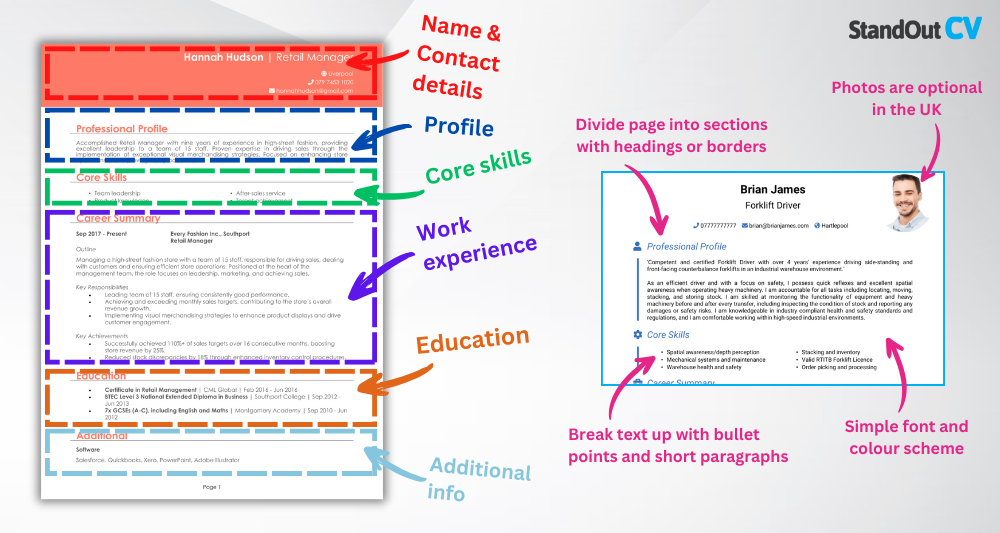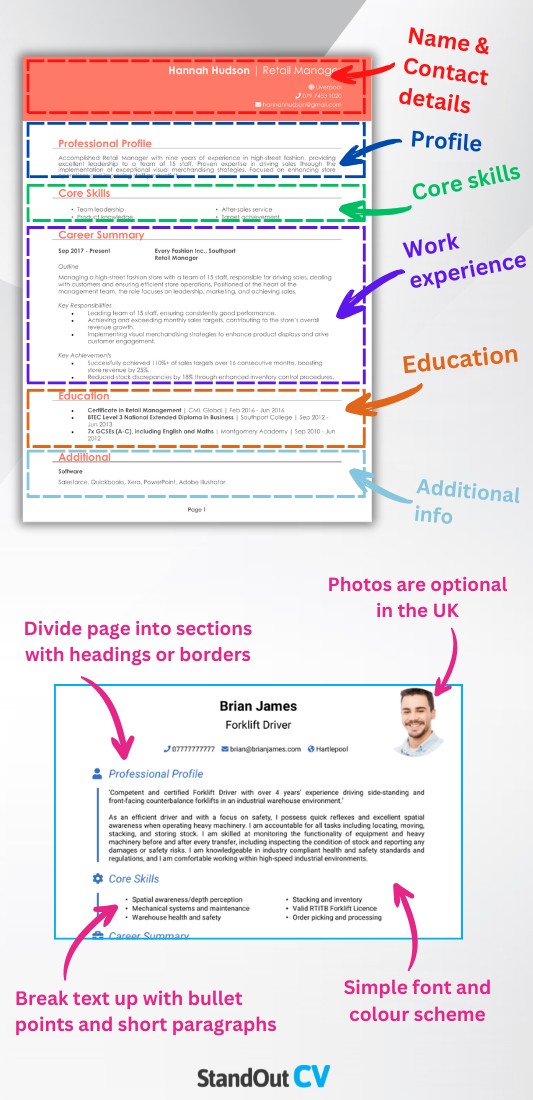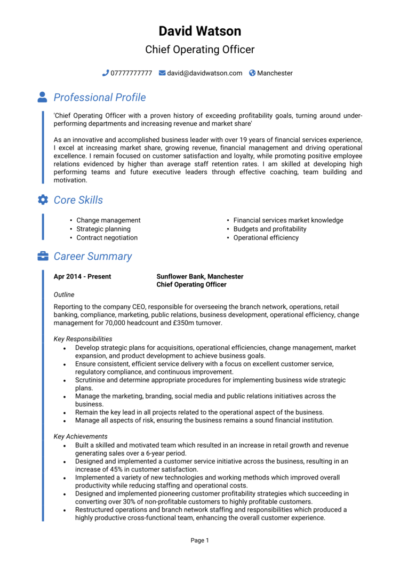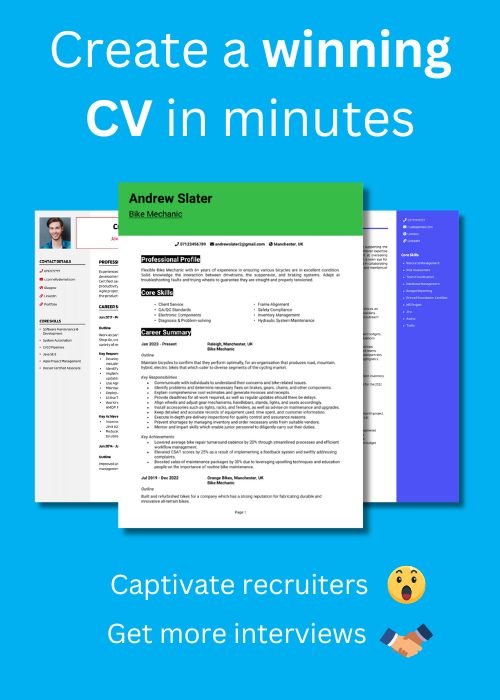Operations don’t run on autopilot – they run on the clear strategy and the kind of oversight only a great Chief Operating Officer (COO) can provide. Whether you’ve scaled companies from the ground up or optimised mature systems for growth, your CV needs to reflect not just what you’ve done, but how effectively you did it.
Along with a Chief Operating Officer CV example, this guide will help you create a polished, authoritative application that conveys executive-level leadership and the operational strength that makes a business scalable – and worthy of investment.
Chief Operating Officer CV

How to write your Chief Operating Officer CV
Discover how to craft a winning Chief Operating Officer CV that lands interviews with this simple step-by-step guide.
Your CV needs to reflect the breadth of your duties as a Chief Operating Officer. Recruiters and boards aren’t looking for someone who just kept things ticking; they want to see evidence that you’ve really led. Your CV must present you as a strategic operator who delivers stability in complexity and growth without chaos.
This guide will walk you through writing your CV that reflects your experience, builds trust with senior stakeholders, and communicates your ability to take businesses from where they are to where they need to be.
Structuring and formatting your Chief Operating Officer CV


A Chief Operating Officer’s CV should be as well-run as the operations they oversee. You’re applying for one of the most senior roles in a company, and your CV needs to show that you understand structure and control. Every detail counts – and the structure you use will say as much about you as the words on the page.
Here’s the layout to follow:
- Name and contact details – Start with your name and contact details – make it simple for recruiters to reach you. Including a photo is a personal choice.
- Profile – Use this section to summarise your experience, strengths, and what makes you a standout candidate.
- Core skills – Outline your primary competencies to give recruiters a snapshot of your strengths.
- Work experience – Walk through your professional experience, beginning with your latest position and moving backwards.
- Education – Outline your education and certifications, focusing on those most relevant to the role.
- Additional info – This section is optional, but it’s a good place for hobbies and interests that complement your CV.
Your formatting should reflect executive professionalism. Use a clear layout with bold section headings, and break down text using bullet points to aid readability. Stick to a clean, authoritative font and make sure there’s enough white space to keep the page breathable. Ideally, the CV length should stay within two pages – long enough to show impact, concise enough to hold attention. Don’t crowd it; lead with clarity, just as you would in a board meeting.
The best way to write a Chief Operating Officer CV profile


Your CV profile section is more than an introduction – it’s your positioning statement as an executive leader. This is where you communicate what kind of COO you are, the scale and scope of what you’ve led, and the business value you deliver.
Avoid the mistake of generic summaries and make this a clear reflection of your leadership style and strategic impact: you’ve only got a few lines to convince recruiters of your value.
Chief Operating Officer CV profile examples
Profile 1
Experienced Chief Operating Officer with over 20 years of leadership in multinational corporations, driving operational excellence and organisational growth. Skilled in overseeing global business operations, implementing efficiency strategies, and aligning resources with long-term strategic objectives. Proficient in ERP systems such as SAP and Oracle, with expertise in corporate governance, compliance, and change management. Recognised for scaling operations and delivering consistent improvements in productivity and profitability.
Profile 2
Strategic Chief Operating Officer with 12 years of experience in technology and SaaS companies, overseeing product development, customer success, and cross-functional operations. Adept in Agile methodologies, data-driven decision-making, and stakeholder management. Experienced in implementing digital transformation initiatives that enhance customer experience and operational scalability. Known for building collaborative cultures that drive performance and innovation.
Profile 3
Dynamic Chief Operating Officer with six years of experience in fast-growing start-ups, managing rapid business expansion and operational restructuring. Skilled in fundraising support, investor relations, and building scalable processes across finance, HR, and supply chain. Proficient in using CRM and project management tools such as Salesforce and Asana. Passionate about building resilient organisations capable of adapting to changing market conditions.
Details to put in your Chief Operating Officer CV profile
Here are some tips on what to put in your CV profile:
- Where you worked – Explain the types of companies you’ve led operations for, including their size, sector, and stage of growth.
- Your top qualifications – Mention relevant executive-level credentials, such as your degrees, MBA, or professional certifications.
- Essential skills – Describe your operational strengths, such as strategic planning, change management, cost optimisation, or scaling processes.
- Teams or functions led – State the departments, teams, or global functions you’ve overseen and how you integrated them under one vision.
- Value delivered – Focus on outcomes – such as improved EBITDA, organisational restructuring, international expansion, or major efficiency gains.
How to present your core skills section properly


For a role at this level, your CV skills need to speak directly to boardroom needs. This section should reflect your operational maturity and strategic expertise without becoming too granular. Rather than listing generic soft skills or vague attributes, include the abilities that align with what CEOs and boards look for in a second-in-command.
Use the job specification as your guide – and reflect the capabilities that show you can stabilise operations and build scalable business infrastructure across teams and regions.
Key skills that make a Chief Operating Officer CV stand out
- Operational Strategy Development – Designing and implementing business operations strategies that align with organisational goals and drive efficiency.
- Cross-Departmental Leadership – Overseeing and coordinating activities across departments such as finance, HR, marketing, and logistics.
- Performance Monitoring and Optimisation – Setting KPIs, analysing performance data, and driving continuous improvement across business units.
- Process Improvement and Efficiency – Identifying operational bottlenecks and leading initiatives to streamline workflows and reduce costs.
- Risk Management and Compliance – Ensuring all operations adhere to regulatory standards and proactively managing business risks.
- Financial Planning and Budget Oversight – Collaborating with the CFO to manage budgets, forecasts, and operational spending.
- Team Development and Talent Management – Building high-performing teams, overseeing recruitment, and promoting leadership development.
- Technology and Systems Integration – Leading the adoption and optimisation of systems that support scalability and operational excellence.
- Executive Collaboration and Decision Support – Partnering with the CEO and board to shape company strategy and provide data-driven recommendations.
- Supplier and Partner Relationship Management – Managing key external relationships to ensure supply chain efficiency and service quality.
How to present your work experience in your CV


As a Chief Operating Officer, your work experience is the heart of your CV. It should show how you’ve created meaningful operational improvements, built and led high-performing teams, and turned strategic goals into working realities. Recruiters will want to see both the complexity of your remit and the concrete results you’ve delivered.
List your most recent roles first and work backwards. Start each entry with a short summary of your role and its context, followed by bullet points that describe your key responsibilities and notable achievements. Focus on what you improved or delivered – and use metrics wherever possible to anchor your value.
How should you list jobs on your Chief Operating Officer CV?

- Outline – Summarise the organisation, the size or scope of operations, and your leadership remit – including teams, budgets, or business units under your control.
- Responsibilities – Use power words like “spearheaded” and “realigned.” For example: “spearheaded global supply chain transformation across three regions” or “realigned operational processes post-acquisition to integrate teams and reduce costs.”
- Achievements – Back up your leadership with measurable impact: revenue growth, margin improvement, cultural turnaround, reduced turnover, or successful change programmes.
Work history examples for Chief Operating Officers
Chief Operating Officer | Arden Global Logistics
Outline
Directed international operations for a large logistics provider specialising in freight forwarding and supply chain solutions. Oversaw business performance across Europe, Asia, and North America while ensuring compliance with global trade regulations.
Responsibilities
- Led operational teams of over 500 staff across multiple regions
- Monitored KPIs and financial performance to support strategic decision-making
- Implemented new ERP systems to standardise reporting and workflows globally
- Built strong relationships with key clients, regulators, and industry partners
- Oversaw compliance programmes to meet international trade and customs regulations
Achievements
- Increased operational efficiency by 22% through supply chain optimisation
- Negotiated global supplier contracts delivering £15m in annual savings
- Reduced cross-border delays by 30% by digitising customs documentation
Chief Operating Officer | Nexora Technologies
Outline
Oversaw day-to-day operations for a fast-growing SaaS company delivering cloud-based enterprise solutions. Supported scaling of development, sales, and customer success teams during a period of rapid expansion.
Responsibilities
- Managed cross-functional collaboration between product, sales, and operations teams
- Introduced Agile frameworks across product development and delivery functions
- Implemented customer success programmes to reduce churn and boost retention
- Oversaw recruitment and onboarding processes for scaling teams
- Reported directly to the CEO and board on operational performance and growth metrics
Achievements
- Increased client retention by 18% with new customer success initiatives
- Supported 3x revenue growth over three years through operational scalability
- Reduced product release cycles by 25% by embedding Agile practices
Chief Operating Officer | Brightlane Ventures
Outline
Led operational strategy for a venture-backed start-up accelerator supporting early-stage businesses in fintech and healthcare sectors. Built systems and processes to support rapid scaling and investor engagement.
Responsibilities
- Developed operational frameworks for portfolio companies to ensure scalability
- Managed financial planning and budgeting processes across the accelerator
- Supported investor relations and contributed to fundraising strategies
- Oversaw HR policies, staff training, and leadership development initiatives
- Implemented CRM tools to track portfolio performance and client engagement
Achievements
- Secured £50m in venture funding through robust operational and investor reporting
- Helped 10 portfolio companies achieve successful Series A rounds within two years
- Reduced operational overheads by 20% through streamlined processes and automation
Presenting your education history


While experience carries the most weight at this level, your education section still needs to reflect your academic foundation and any executive training you’ve undertaken. Lead with your most senior qualification – such as an MBA or degree – and include the name of the institution and completion date.
If you’ve completed other leadership development programmes or certifications (such as Lean Six Sigma, CMI, or INSEAD short courses), you can include those too – especially if they align with the operational nature of the role.
Best qualifications for a Chief Operating Officer
- MBA (Master of Business Administration) – Strong leadership and strategy credential for senior execs
- BA/BSc in Business, Management, or Engineering – Provides essential foundation in core operational principles
- Lean Six Sigma Certification – Supports process improvement and efficiency goals
- Chartered Manager Status (CMI) – Demonstrates senior management competence and credibility
- Finance or Supply Chain Executive Training – Shows you’ve strengthened domain knowledge beyond general management





